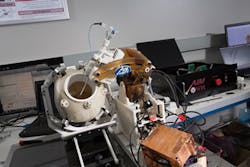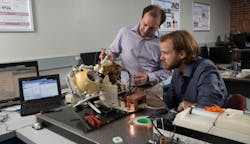New Robotic System Aims to Destroy Brain Tumors
Brain metastases are among the most common type of brain tumors, occurring when primary cancers in other organs in the body spread to the brain. Each year an average of 170,000 new cases are diagnosed in North America alone. Currently, the only available treatment options are chemotherapy, radiation, and surgery, all of which have limited effectiveness. Chemotherapy and radiation can damage unaffected brain tissue, and surgery is only possible when tumors are in accessible locations.
To help find alternative methods for fighting these illnesses, researchers at Worcester Polytechnic Institute (WPI) and Albany Medical College have received an award to continue development for their brain tumor-destroying robotic system. The universities, along with corporate partners GE Global Research and Acoustic MedSystems Inc., received the five-year, $3.5 million awards from the National Institutes of Health (NIH) through the National Cancer Institutes’ (NCI) Academic-Industrial Partnership program. The robotic system operates within an MRI scanner and delivers a minimally invasive probe into the brain to destroy metastatic brain tumors with the use of high-intensity therapeutic ultrasounds under real-time guidance.
The robotic system will insert a probe inside the patient’s brain tumor, whereupon proper placement will deliver tumor destroying high-energy ultrasounds.
The grant will enable the research team to model the behavior of the ultrasound ablation system, use thermal monitoring to provide real-time feedback on dose delivery, optimize how the system verifies effectiveness, and certify its readiness for human clinical trials.
The system works by inserting a 2 mm diameter probe into the brain via a small drilled hole in the skull and placed within the tumor. The probe’s orientation and power output are then adjusted within the tumor for optimized delivery of the high-intensity ultrasound energy, which is lethal to tumors. The ultrasound energy kills the tumor by heating it, also known as thermal ablation, and the heat makes it possible to detect the amount of ultrasound energy delivered via an MRI scanner. This how doctors can ensure the correct dosage of ultrasounds via thermal emissions. The ultrasound energy is a more targeted approach and minimizes the damage done to the surrounding brain tissue.
The core of the system is the robot that is capable of operating inside an MRI scanner. Prior to being inserted into the brain, the robot will position and align the probe. While the procedure is underway, the robot will adjust the depth and rotate the probe to conform to the shape of the tumor. Real-time MRI scans will ensure the probe’s location and that it has been perfectly placed inside the tumor. The robot’s design is precise to operate within the confines of the MRI scanner. It takes into consideration the surrounding equipment, like anesthesia equipment, imaging coils, and patient monitoring apparatus.
It is also designed without ferrous metals. The robot is mainly constructed from plastics and ceramics; it uses piezoelectric motors and custom motion-control electronics that generate very low levels of electrical noise to avoid interfering with the MRI imaging system. The parts that come in contact with the patient can be easily sterilized to operate safely within a surgical environment.
Mechanical engineering professor Gregory Fischer, left, and research scientist Christopher Nycz examine a prototype of the MRI-compatible robotic system for treating brain tumors developed in the first phase of the NIH-funded research program. (Image credit: WPI)
The research team is led by principal investigators Gregory S. Fischer, Ph.D., associate professor of mechanical engineering and robotics engineering at WPI and director of the Automation and Interventional Medicine Laboratory, and Julie G. Pilitsis, M.D., Ph.D., chair of the Department of Neuroscience and Experimental Therapeutics and professor of neurosurgery at Albany Medical College.
Fischer and Pilitsis will work closely with the two corporate partners. The needle-based therapeutic ultrasound will be designed, built, and validated by Acoustic MedSystems in Savoy, Ill. The company will also provide the software to visualize and control it. GE Global Research Center in Niskayuna, N.Y., will implement thermal imaging capabilities to monitor the thermal ablation of the tumor tissue in real time and will collaborate on integrating the robotic system with its clinical MRI scanner.
“Thermal ablation has shown potential as an effective treatment,” Pilitsis said, “but the available devices for using this therapy have severe limitations and can’t treat all shapes, sizes, and locations of tumors. Our hope is that this integrated robotic system will one day be able to provide all brain tumor patients with a safer, more accurate treatment.”
“Our system is designed to provide very precisely, closed-loop control,” Fischer said. “We will use live MRI images and thermal imaging to control the pattern of the ablation and monitor and adjust it in real-time to confine the thermal effects to the area within the tumor boundaries, and to ensure that we are maximizing the odds that we are removing the entire tumor, while minimizing the chances of damaging non-malignant tissue.”
The WPI team is also developing a modular controller to operate the robot and integrate the robotic system with multiple other systems—including the MRI scanner, the software that controls the Acoustic MedSystems probe, and the 3D navigation software. The team from WPI includes Ph.D. candidates Paulo Carvalho and Katie Gandomi and research scientist Christopher Nycz, Ph.D. According to Fischer, the goal is to deliver a system that can be easily integrated into the workflow inside a surgical suite. “When we get to clinical trials we won’t be able to have an army of engineers on site,” he said. “So, we need to get to the point where everything runs very, very smoothly.”
Some of this work will be conducted at WPI’s PracticePoint R&D facility for medical cyber-physical systems, a membership-based research, development, and commercialization alliance founded to advance healthcare technologies. Currently, under construction at WPI’s Gateway Park campus, PracticePoint will have a hybrid operating room, a medical imaging suite, a reconfigurable patient care suite, a rehabilitation lab, and a residential setting. The research facility will explore how smart medical devices and systems can be developed and tested. The surgical imaging suite will include a 3-Tesla MRI scanner made by GE Healthcare.
Fischer and the research team are looking towards the future and consider what other applications can use the ultrasound technology. “We are creating a versatile stereotactic neurosurgery delivery device,” he said, “one with much broader potential applications. For example, we could use it to deliver other ablation technologies, to do biopsies, to do electrode placement for deep-brain stimulation, and even to deliver therapeutics such as gene therapy. This research has opened up a world of exciting possibilities.”



